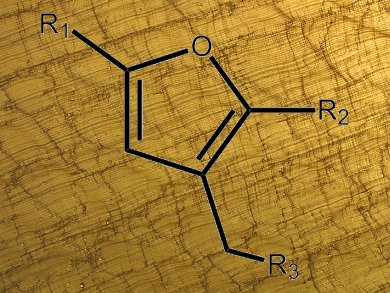Furans For All
In many significant natural products, furans are a key motif. These oxygen-containing five-membered heterocycles are also versatile building blocks in the construction of highly complex target structures. As such, they are important scaffolds in organic and pharmaceutical chemistry. A. Stephen K. Hashmi and a team at Universität Heidelberg, Germany, have introduced a general protocol for the preparation of highly substituted furans through a gold-catalyzed cyclization reaction.
The efficiency of reactions is often thought of in terms of atom economy, and the search for more efficient alternatives to classical chemical reactions is now an area of intense research. In this context, transition-metal catalysts are becoming a popular choice amongst chemists, because they are often used in only very small amounts, which conforms to the atom-economy rule and minimizes waste. Notably, in contrast to the often harsh conditions required to perform classical chemical transformations, most transition-metal catalyzed reactions can be performed under mild reaction conditions and within a short timeframe.
Gold-Catalyzed Cyclization
Because gold catalysts are robust, their popularity has increased significantly in the last few years. Gold catalysts can easily be handled in air, and they are also tolerant to water. Moreover, gold catalysts often show higher activity and higher selectivity than their more popular palladium counterparts. Gold is particularly well suited for substrates that bear a triple carbon–carbon bond (i.e., an alkyne), as it coordinates preferentially to this bond, resulting in a highly reactive complex that is prone to attack. As such, the gold-catalyzed cyclization of an alkyne tethered to an alcohol can provide easy access to highly substituted furans.
The German research team found that the gold(I)-catalyzed cyclization of various 2-alkynylallyl alcohols proceeded well and afforded the desired furan products with the use of low catalyst loadings under very mild reaction conditions. Importantly, both di- and trisubstituted furans could be obtained, which allows structural variety in the building blocks. Bifunctional substrates could also be cyclized to provide chemically interesting bisfurans. This synthetically simple route provides quick and easy access to highly substituted furan building blocks, which may help to facilitate the study of this important class of compounds.
- Cyclization of 2-Alkynylallyl Alcohols to Highly Substituted Furans by Gold(I)–Carbene Complexes
A. S. K. Hashmi, T. Häffner, M. Rudolph, F. Rominger,
Eur. J. Org. Chem. 2011.
DOI: 10.1002/ejoc.201001479




